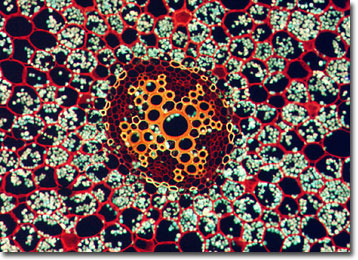Fluorescence Digital Image Gallery
Herbaceous Stems
Stems, crucial structures in advanced plants, have been utilized for human purposes for thousands of years. For instance, more than 4,500 years ago the ancient Egyptians created the first form of paper from the fibrous stems of the grass-like plant known as papyrus. Also, many popular spices, such as ginger, have been derived from the stems of plants throughout the ages.

The stems of herbaceous plants tend to be somewhat soft and flexible because they contain very little of the woody material characteristic of bushes and trees. Instead, they are primarily composed of vascular bundles (xylem and phloem) arranged in a circle around a central core of spongy tissue made up of parenchyma cells, or pith. A layer of tissue known as the cortex surrounds the vascular bundles and may vary in thickness depending upon species. Another layer of cells called the epidermis encircles the cortex. In conjunction, the various materials of the stem carry out the structure’s primary functions, which include providing support to leaves and flowers, as well as transporting water, minerals, and the products of photosynthesis throughout the plant.
Though the most familiar type of herbaceous stem is the upright structure frequently seen supporting common flowers, there are many different types. Some stems, like those of cucumber plants, lie prostrate on the ground, while others twine upward with the aid of tendrils. Horizontal stems that grow underground are known as rhizomes and are characteristic of a variety of flora, including the common iris. Stems that grow beneath the surface of the soil may also be found in an upright position. These short, fleshy structures are usually called tubers, but when they are enlarged with stored food the stems are known as corms.
BACK TO THE FLUORESCENCE DIGITAL IMAGE GALLERY
